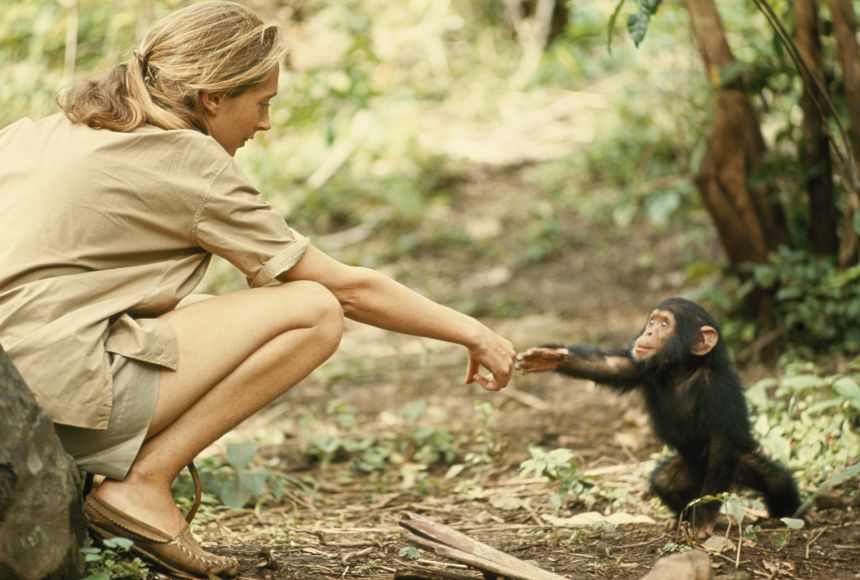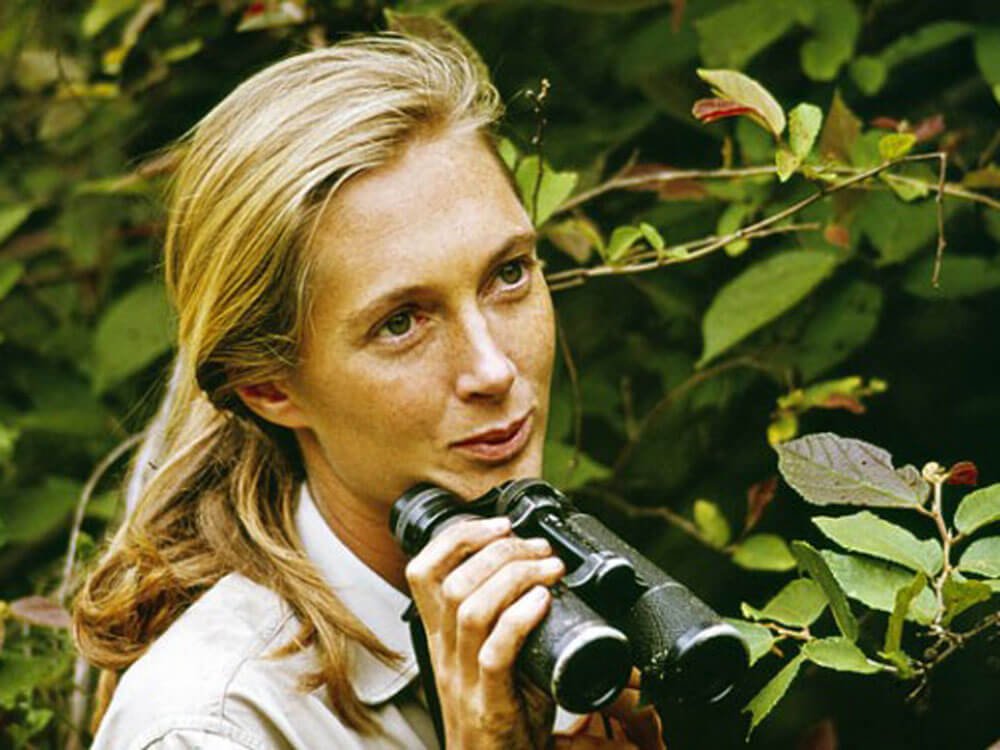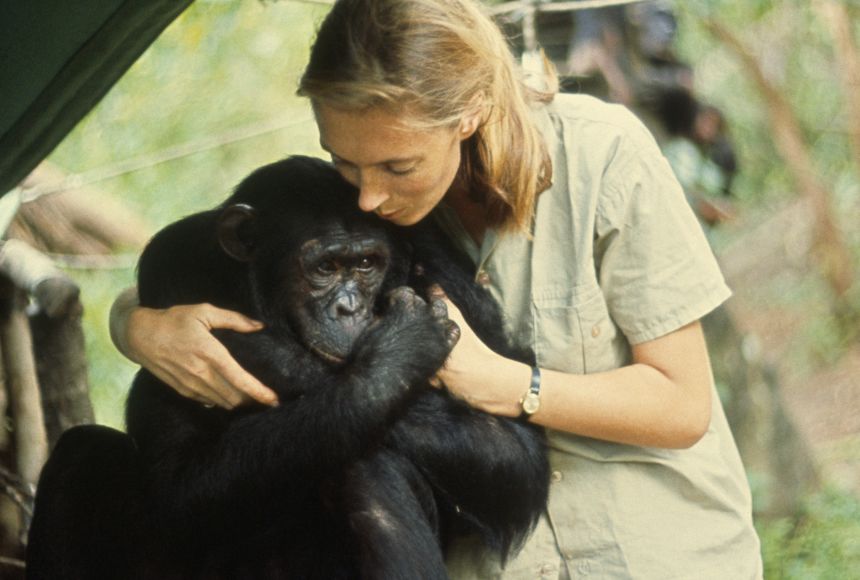A Moment in the Forest That Echoes Forever
I still remember that image. A woman in khaki, sitting quietly in the middle of a green forest. Around her, the world hummed softly with life. She wasn’t talking or moving. She was simply there, still, attentive, patient. A chimpanzee approached, curious but cautious. The space between them held no fear, only understanding.
That woman was Jane Goodall.
When I first watched her on screen years ago, I didn’t realize how deeply she would change the way the world sees nature or how much she would shape my own sense of wonder.
And now, as the world says goodbye to her, that forest moment feels even more powerful.
On October 1, 2025, Jane Goodall passed away peacefully in her sleep in Los Angeles at the age of 91. She had been traveling on one of her speaking tours, still doing what she loved most – sharing her message of hope and harmony.
It’s strange how someone’s death can make the world fall quiet for a moment. Hers did.
The Little Girl Who Dreamed of Africa
Jane wasn’t born into privilege or fame. She was born on April 3, 1934, in London, a curious child who loved animals more than dolls. When other kids ran around playing games, she sat still, watching birds or reading about lions and apes.
One of her favorite childhood stories was Tarzan of the Apes. She used to tell people, half laughing, half serious, “Tarzan married the wrong Jane.”
At four years old, she disappeared for hours into a chicken coop, wanting to see with her own eyes how an egg was laid. Her mother, instead of scolding her, listened as Jane excitedly explained what she had seen. That small act of understanding planted something big, a belief that curiosity is sacred.
When Jane was 23, she saved enough money to travel to Kenya. There, she met Dr. Louis Leakey, the legendary anthropologist who would change her life. He saw something in her, curiosity without ego, courage without aggression, and invited her to study chimpanzees in what is now Gombe Stream National Park, Tanzania.
She had no formal degree, no scientific training, no team. Just binoculars, notebooks, and boundless fascination.
And that was enough.
The First Days in the Wild
The beginning was lonely. The chimps fled every time she came near. Days turned to weeks, and weeks to months. Still, Jane didn’t give up. She climbed hills, crossed rivers, and sat for hours watching from afar until, slowly, they began to trust her.
Then one day, everything changed.
She saw a chimp, later named David Greybeard, reach into a termite mound with a twig, pull it out, and lick off the termites.
It was a breathtaking moment. Chimps weren’t just using nature. They were shaping it. For decades, scientists believed only humans made tools. That single observation shattered the definition of what it meant to be human.
Jane didn’t see that moment as proof of superiority or novelty. To her, it was proof of kinship.
She said later, “We are not the only beings with personalities, minds, and feelings.”
Through her quiet patience, Jane redefined how we see the animal kingdom, not as a separate world, but as part of our shared family.

The Courage to Be Different
In the 1960s, science was dominated by men, and emotions were seen as weakness. Many experts criticized Jane for giving the chimpanzees names instead of numbers. They said she was “too sentimental.”
But she stayed true to her instincts. She believed that compassion could exist alongside observation, and that science didn’t need to be cold to be valid.
She continued to observe, record, and publish her findings. In time, the world began to see what she had seen all along. That empathy can be the sharpest form of intelligence.
Her research eventually earned her a PhD from Cambridge University, even though she had never completed an undergraduate degree. She became one of the few scientists to bridge the worlds of academic research and emotional intuition.
Beyond the Forest
As the years went on, Jane’s focus began to shift.
She started to see the larger picture: forests shrinking, chimpanzees hunted, communities struggling. Science alone was no longer enough. She needed to act.
In 1977, she founded the Jane Goodall Institute, which today runs conservation and community programs across Africa. In 1991, she launched Roots & Shoots, a global youth movement that empowers students to create positive change in their own communities.
What started as a handful of students in Tanzania grew into millions of young people across 100 countries. Their projects range from planting trees to recycling, from protecting wildlife to helping the elderly.
Jane believed deeply in the next generation. She used to say, “Every individual matters. Every individual has a role to play. Every individual makes a difference.”
She also became a UN Messenger of Peace in 2002, using her voice to advocate for sustainability, animal welfare, and hope in the face of climate change. Even into her late 80s and early 90s, she spent nearly 300 days a year traveling and speaking.
Her stamina wasn’t fueled by coffee or fame. It was fueled by purpose.
Her Final Days
In late September 2025, Jane was preparing for a series of public talks in California. Friends said she had been tired but cheerful, excited about the upcoming launch of an updated Roots & Shoots curriculum.
On the morning of October 1, her longtime assistant found her asleep in her hotel room. Peaceful. Resting. Gone.
The Jane Goodall Institute confirmed her passing that evening. Within hours, tributes poured in from around the world: scientists, activists, celebrities, presidents, and millions of ordinary people who had been touched by her words.
Prince William called her “a woman who challenged us all to make a difference.” The United Nations described her as “a guardian of the Earth’s soul.”
It was a global wave of gratitude, proof that one person’s kindness can ripple far beyond a lifetime.

The Words She Left Us
In her final recorded interview, released shortly after her death, Jane spoke with the same mix of humor and gravity that made her unforgettable.
She joked about wanting to send certain world leaders “on a one-way trip to space,” but beneath the laughter, she offered her last wish:
Don’t lose hope. Act locally. Think globally. Every day matters.
Her assistant, Mary Lewis, later shared that Jane was working until her very last day: reviewing documents, signing letters, and leaving voice notes for her team. “She never stopped believing in people,” she said.
Even in her final hours, Jane was teaching. Not about chimpanzees anymore, but about life itself.
The Legacy She Leaves
Jane Goodall’s life gave us lessons that reach far beyond science.
1. Listen Before You Speak
In a world full of noise, Jane’s power came from her silence. She listened to the forest before she tried to explain it. She watched before she spoke. In that quiet, truth revealed itself.
2. Kindness Is Strength
Her approach wasn’t forceful or loud. It was gentle, yet firm. She showed that kindness can create deeper change than confrontation ever could.
3. You Don’t Need Permission to Start
Jane began her journey without a degree, funding, or fame. What she had was curiosity and persistence. The world eventually caught up with her vision.
4. Everything Is Connected
She taught that humans, animals, and ecosystems are woven together. Hurt one thread, and the whole tapestry trembles. Care for one, and everything heals a little.
5. Hope Is a Daily Practice
Jane wasn’t naive. She saw destruction up close. But she chose hope every day. Hope, for her, wasn’t optimism. It was action.
How We Can Honor Her
It’s easy to admire Jane’s life and think, “I could never do that.” But the truth is, she didn’t expect us to become her. She expected us to start where we are.
Here are small ways to live her message:
-
Observe nature. Spend time outside, even just five minutes. Notice the details.
-
Protect something you love. A stray dog, a local park, a beach cleanup, it all counts.
-
Support young changemakers. Encourage curiosity in children. Teach them that their ideas matter.
-
Speak kindly. Act consciously. Live gently.
In her eyes, every choice was a vote for the kind of world we want.
A Quiet Goodbye
When I imagine Jane now, I see her back in the forest. The sun slipping through the trees. The air thick with the sound of leaves and wings. She’s sitting still again, notebook on her lap, smiling softly as the chimpanzees play nearby.
She’s home.
And maybe that’s the lesson, that we’re all at home here, on this planet, if only we learn to treat it that way.
Jane Goodall didn’t just study nature. She belonged to it. And through her, we learned that we do too.

